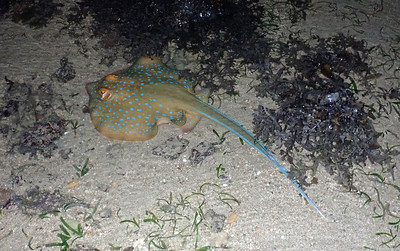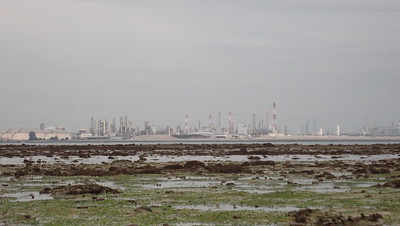 |
| A shy yellow filefish as the sun rises over Cyrene. |
At night, fishes are easier to find and photograph. Unlike in the daytime, when they are well hidden. I saw many fishes typical of our reefs on our early morning survey. These include large but well camouflaged ones like filefishes. And smaller colourful ones like butterflyfishes and damselfishes and wrasses.
Instead of rushing away, this colourful Head-striped goby displayed its fins and shiny bits for me! This rather large goby is common on the reefs, but seldom seen during the day.There were a lot of large Fringe-eyed flatheads out in the open, probably waiting for prey to pass near by. At night, they won't rush away immediately when we step carefully close to them. In the daytime they are probably buried just beneath the sand.
At night it is easier to sneak up on large fishes. Here's a very commonly seen Blue-spotted fantail ray that lay quietly as I approached it.
Shy animals like brittle stars are also easier to spot at night. During the day, the big ones are well hidden in crevices, while small ones that live on other animals are well tucked away.
Crabs are also out and about in the dark and easier to spot and photograph. So many different colourful ones, mostly swimming crabs. Plus one well-camouflage Common hairy crab clutching a clump of seaweed, probably to eat.You have a better chance of seeing octopuses at night, as they are more active then. But today, all the reef octopuses I saw were very shy, and small. And they are hard to spot when they stop moving, and change colours and texture to match their surroundings! But by waiting patiently without moving, eventually, they will start moving again. I managed a half shot of one tiny octopus swooping past my bootie.
It was great to see a rather large Fluted giant clam near the landing point. Is it the same one that Kelvin spotted on our last survey in Jun 2020?
I didn't see any bleaching hard corals. The large corals I saw today seemed alright. I feel the threat of mass coral bleaching is over for the year.
The leathery soft corals that I saw were also alright.
The sand bar seems to have gotten much flatter (not so tall), broader and moved towards the east. There is no longer any seagrass east of the sand bar, perhaps the sand bar has buried them?
The sandy area doesn't seem so rich as before. I only saw a few Common sea stars and Cake sand dollars. There were a lot of Oval moon snails, but Kok Sheng came across this interesting moon snail which might be the Eggwhite moon snail.
There is a narrow stretch of seagrasses east of the sand bar, closer to Jurong Island.Some parts had really dense growths of seagrasses
I saw a few furrows that might be dugong feeding trails. I saw many feeding trails on our last survey in this area in Jun 2020.
In the past, we used to see lots of Knobbly sea stars as soon as we landed on the western end of Cyrene. We missed seeing them for some time. Today, I saw lots of them further west of our landing point! It seems they really do prefer to be on seagrass.
Although it lies in the middle of an industrial triangle and major shipping lanes, Cyrene has some of Singapore's most amazing shores. The 'star' of Cyrene are the Knobbly sea stars, so we are glad to see them still present in numbers on the western end of this submerged reef.
It's nice to see the usual variety of Knobblies in their different colours and patterns!There were still huge piles of sand on Jurong Island nearest the western tip of Cyrene. In Jan 2019, I had already had suspicions that the ongoing reclamation at Jurong Island might be affecting Cyrene.
A large area on Jurong Island (Ayer Merbau Basin) near Cyrene is being reclaimed - area outlined in red in this map on the MPA website.
 |
| Image from the MPA website |
From Port Marine Notice 109 of 2018, these reclamation works have been going on since Jan 2018 and expected to be completed in May 2019. I had noticed the reclamation during our Apr 2018 survey.
 |
| From Port Marine Notice 109 of 2018. |
Photos by others on this survey
Vincent Choo
Loh Kok Sheng



















